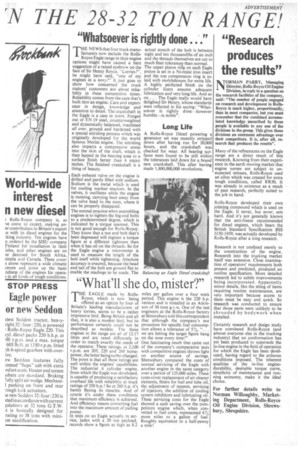"What'll she do, mister?"
Page 13

If you've noticed an error in this article please click here to report it so we can fix it.
THE EAGLE made by RollsRoyce, which is now being offered as an option by four of Britain's leading manufacturers of heavy lorries, seems to be a rather impressive bird. Being British and all that, it is also a modest bird, but its performance certainly could not be described as modest. The three engines in the range are all of 12.17 litres and are rated differently in order to match exactly the needs of the operator. These ratings, at 2,100 r.p.m. are 205, 220 and 260 horsepower, the latter being turbo-charged. The point is that all thee rating§ are well within the engines' capabilities. The industrial 6 cylinder engine, from which the Eagle was developed, is capable of producing a satisfactory overhaul life with reliability at truck ratings of 350 h.p.! So at 260 h.p. it's barely flexing its muscles. And of course it's under these conditions that maximum efficiency is achieved. And efficiency means converting fuel into the maximum amount of pulling power.
In tests on an Eagle actually in service, laden with a 20 ton payload, records show a figure as high as 8.2 miles per gallon over a four week period. This engine is the 220 h.p. version and is installed in an Atkinson of 30 tons g.v.w. One of the test engineers at the Rolls-Royce factory at Shrewsbury told this correspondent that although the company's test procedure for specific fuel consumption allows a tolerance of 5%, ". . we are hitting the target figure bang on the nose every time!"
One fascinating result that came out of the company's comparative tests with competitive engines throws light on another source of savings. Shrewsbury compared the costs of normal servicing of the Eagle with another engine in the same category over a period of 125,000 miles. These costs cover replacement of air cleaner elements, fitters for fuel and lube oil, the adjustment of tappets, servicing of injectors, the addition of cooling system inhibitors and lubricating oil. These servicing costs for the Eagle showed a cash saving over the competitors engine which, when converted to fuel costs, represented 6% more miles to a gallon of fuel. Roughly equivalent to a half-penny a mile!




































































































































































































































































